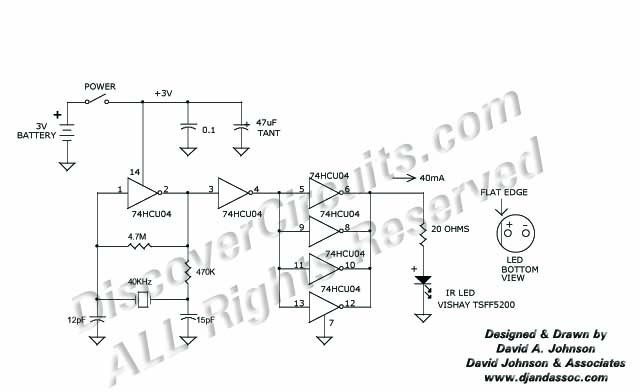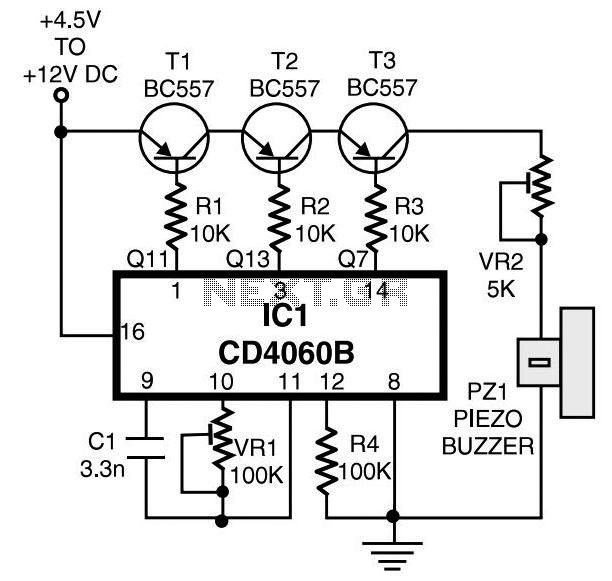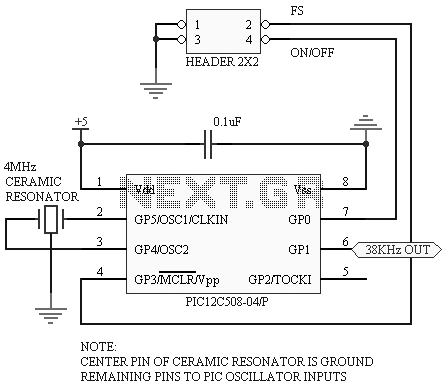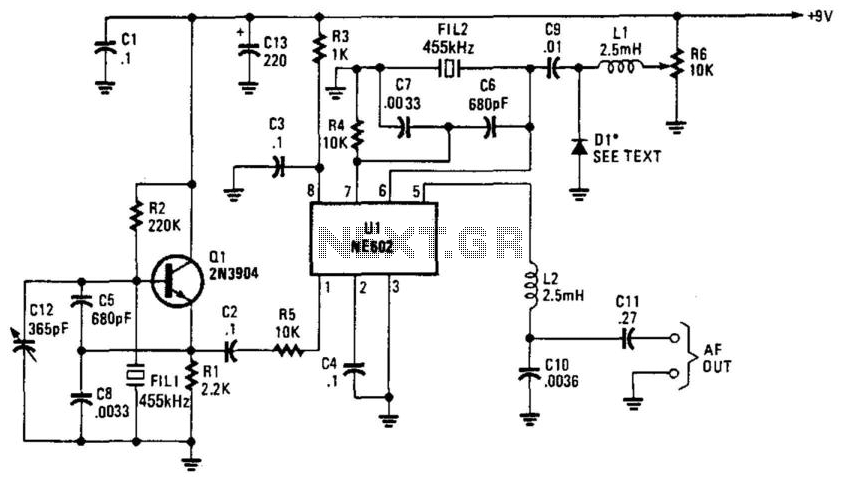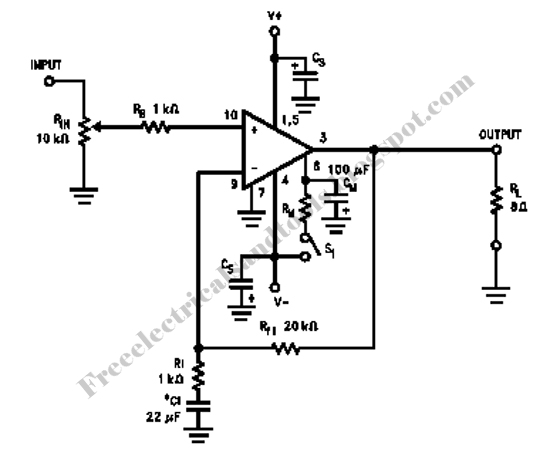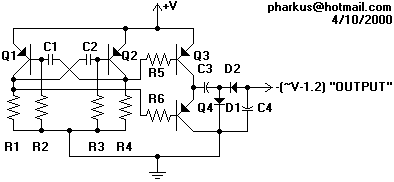
Panner Waveform Generator
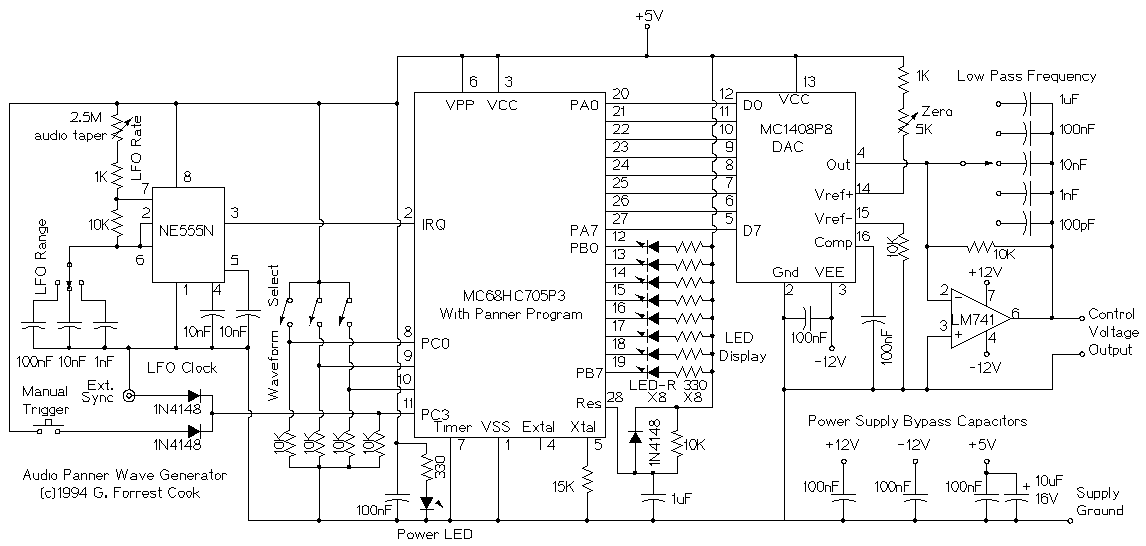
This device is a microprocessor controlled waveform generator that can be used for driving a voltage controlled stereo panner for music applications. Panning is simply the movement of a mono audio signal between the left and right channels of a stereo sound system. The circuit can also be used to drive other voltage controlled modules that are used in analog music synthesis. The output of the waveform generator is a 0-10V DC control voltage. One of eight waveforms can be selected using an 8 position BCD switch. Waves include: ramp, triangle, sine, cos(x)*sin(5x), damped 4 cycle sine wave, and pseudo random. Other waveforms may be substituted by changing the assembly language waveform tables.
The microprocessor-controlled waveform generator functions as a versatile tool for audio applications, particularly in music synthesis and sound design. The core of the device is a microcontroller that manages the generation of various waveforms, which are crucial for creating dynamic audio effects. The output voltage range of 0-10V DC allows compatibility with a wide range of analog equipment, ensuring that the generated control signals can effectively modulate parameters in voltage-controlled devices.
The selection of waveforms is facilitated by an 8-position Binary-Coded Decimal (BCD) switch, which allows users to easily choose among eight distinct waveform shapes. These include basic waveforms such as ramp, triangle, and sine, as well as more complex waveforms such as cos(x)*sin(5x), which combines cosine and sine functions to create intricate modulation patterns. The damped 4 cycle sine wave provides a unique sound characteristic, while the pseudo-random waveform introduces unpredictability, making it suitable for experimental music applications.
The ability to change the assembly language waveform tables further enhances the flexibility of the device, allowing for custom waveform shapes to be defined based on specific user requirements. This feature is particularly useful for sound designers who wish to create unique audio textures or effects that are not available in the standard waveform selections.
In summary, the microprocessor-controlled waveform generator is a powerful tool for musicians and sound engineers, providing a range of waveforms and the ability to control audio signals with precision, thereby facilitating creative sound manipulation in both live and studio settings.This device is a microprocessor controlled waveform generator that can be used for driving a voltage controlled stereo panner for music applications. Panning is simply the movement of a mono audio signal between the left and right channels of a stereo sound system.
The circuit can also be used to drive other voltage controlled modules that are used in analog music synthesis. The output of the waveform generator is a 0-10V DC control voltage. One of eight waveforms can be selected using an 8 position BCD switch. Waves include: ramp, triangle, sine, cos(x)*sin(5x), damped 4 cycle sine wave, and pseudo random. Other waveforms may be substituted by changing the assembly language waveform tables. 🔗 External reference
The microprocessor-controlled waveform generator functions as a versatile tool for audio applications, particularly in music synthesis and sound design. The core of the device is a microcontroller that manages the generation of various waveforms, which are crucial for creating dynamic audio effects. The output voltage range of 0-10V DC allows compatibility with a wide range of analog equipment, ensuring that the generated control signals can effectively modulate parameters in voltage-controlled devices.
The selection of waveforms is facilitated by an 8-position Binary-Coded Decimal (BCD) switch, which allows users to easily choose among eight distinct waveform shapes. These include basic waveforms such as ramp, triangle, and sine, as well as more complex waveforms such as cos(x)*sin(5x), which combines cosine and sine functions to create intricate modulation patterns. The damped 4 cycle sine wave provides a unique sound characteristic, while the pseudo-random waveform introduces unpredictability, making it suitable for experimental music applications.
The ability to change the assembly language waveform tables further enhances the flexibility of the device, allowing for custom waveform shapes to be defined based on specific user requirements. This feature is particularly useful for sound designers who wish to create unique audio textures or effects that are not available in the standard waveform selections.
In summary, the microprocessor-controlled waveform generator is a powerful tool for musicians and sound engineers, providing a range of waveforms and the ability to control audio signals with precision, thereby facilitating creative sound manipulation in both live and studio settings.This device is a microprocessor controlled waveform generator that can be used for driving a voltage controlled stereo panner for music applications. Panning is simply the movement of a mono audio signal between the left and right channels of a stereo sound system.
The circuit can also be used to drive other voltage controlled modules that are used in analog music synthesis. The output of the waveform generator is a 0-10V DC control voltage. One of eight waveforms can be selected using an 8 position BCD switch. Waves include: ramp, triangle, sine, cos(x)*sin(5x), damped 4 cycle sine wave, and pseudo random. Other waveforms may be substituted by changing the assembly language waveform tables. 🔗 External reference
